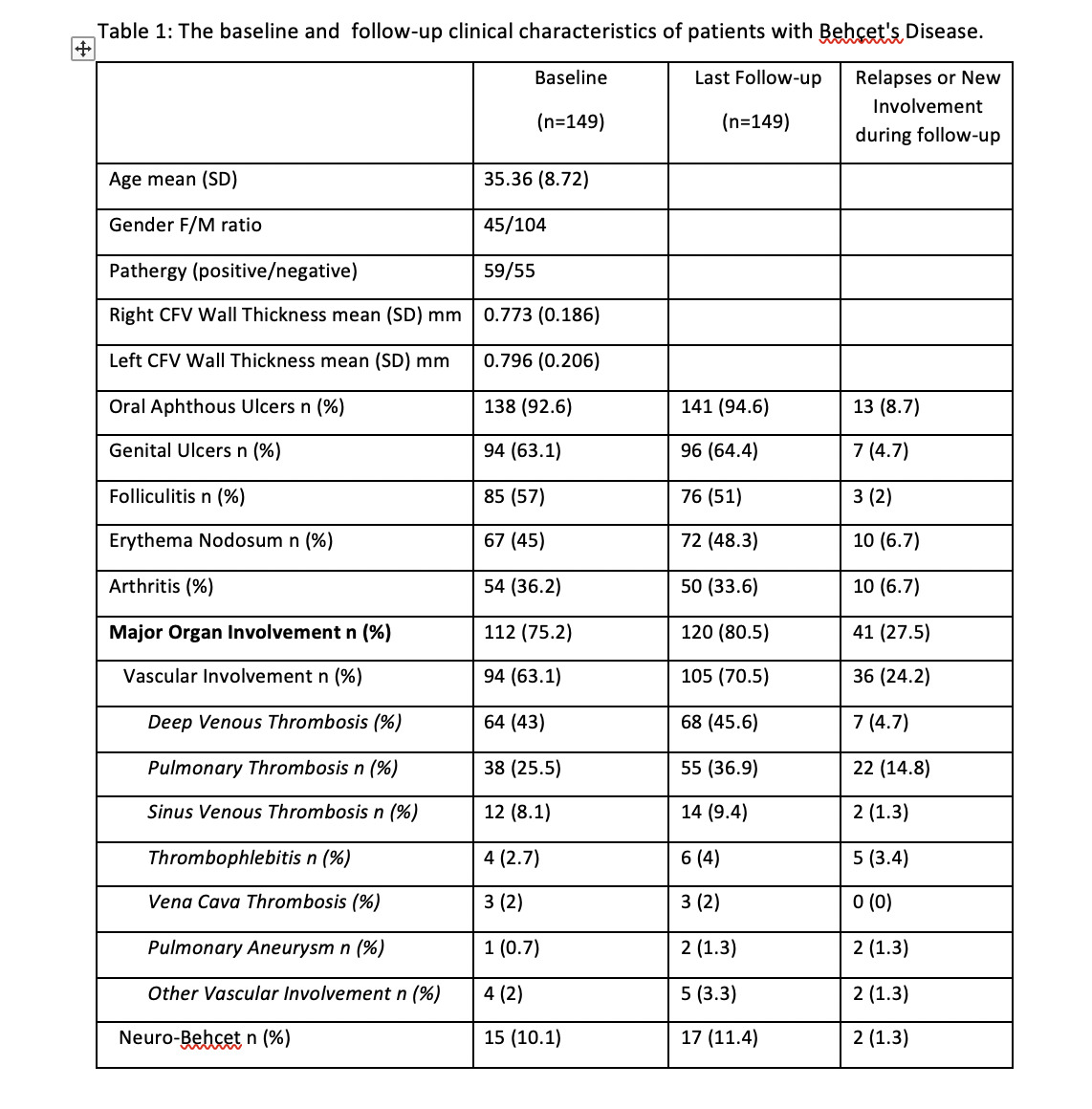Back
Poster Session C
Imaging
Session: (1228–1266) Imaging of Rheumatic Diseases Poster
1264: Does Vein Wall Thickness Have Prognostic Value in Behcet's Disease? A Prospective Follow up Study
Sunday, November 13, 2022
1:00 PM – 3:00 PM Eastern Time
Location: Virtual Poster Hall

Haner Direskeneli, MD
Marmara University
ISTANBUL, Turkey
Abstract Poster Presenter(s)
Kerem Abacar1, Rabia Ergelen2, Fatma Temiz2, Yasin Yildiz2, Tulin Ergun3, Haner Direskeneli4 and Fatma Alibaz-Oner1, 1Marmara University, Rheumatology, Istanbul, Turkey, 2Marmara University, School of Medicine, Departmant of Internal Medicine, Istanbul, Turkey, 3Marmara University, School of Medicine, Department of Dermatology, Istanbul, Turkey, 4Marmara University, Rheumatology, Istanbul, Istanbul, Turkey
Background/Purpose: We reported the first controlled ultrasound study showing increased common femoral vein(CFV) thickness in Behçet's Disease(BD),1 and showed that this is a distinctive feature of BD, rarely present in other inflammatory diseases with a specificity higher than 80% of the cutoff value of ≥0.5 mm.2 This study aimed to assess the prognostic value of CFV thickness during prospective follow-up BD patients.
Methods: We included 195 patients with BD. Bilateral CFV thickness was measured with ultrasonography by an experienced radiologist.Patients were started to follow up prospectively with 3-6 months intervals and in any urgent visit.
Results: At baseline, 98.6% of patients had CFV wall thickness above the cut-off value of ≥0.5 mm(Table 1). 149 patients had prospective follow-up with a mean of 26.03 (16.29) months. New major organ involvement or relapse was seen in 41(27.5%) patients. Among 36 patients with only mucocutaneous disease at baseline, new major organ involvement developed in 9 patients during follow-up. These patients had higher baseline CFV thicknesses compared to patients not developing major organ involvement despite no statistical significance (0.83 mm vs 0.73 mm for right;0.80 mm vs 0.73 mm for left: p >0.05 for both). In 47 patients, the second CFV thickness measurement was done mean 19.8 months later. First and second measurements were found similar (p=0.26, p=0.26 respectively). CFV wall thickness didn't change with the treatment.
Conclusion: CFV wall thickness measurement which is a new diagnostic tool for BD, does not change over time with treatment modality, new organ involvement or relapses. However, our preliminary results suggest that mucocutaneous BD patients with higher CFV thickness may have a higher risk for the development of major organ involvement during follow-up. The long-term results of our prospective cohort would clarify the prognostic value of CFV thickness in BD.
References 1- Alibaz-Oner F,et al. Clin Rheumatol 2019. 2- Alibaz-Oner F,et al. Rheumatology (Oxford) 2021.

Disclosures: K. Abacar, None; R. Ergelen, None; F. Temiz, None; Y. Yildiz, None; T. Ergun, None; H. Direskeneli, None; F. Alibaz-Oner, None.
Background/Purpose: We reported the first controlled ultrasound study showing increased common femoral vein(CFV) thickness in Behçet's Disease(BD),1 and showed that this is a distinctive feature of BD, rarely present in other inflammatory diseases with a specificity higher than 80% of the cutoff value of ≥0.5 mm.2 This study aimed to assess the prognostic value of CFV thickness during prospective follow-up BD patients.
Methods: We included 195 patients with BD. Bilateral CFV thickness was measured with ultrasonography by an experienced radiologist.Patients were started to follow up prospectively with 3-6 months intervals and in any urgent visit.
Results: At baseline, 98.6% of patients had CFV wall thickness above the cut-off value of ≥0.5 mm(Table 1). 149 patients had prospective follow-up with a mean of 26.03 (16.29) months. New major organ involvement or relapse was seen in 41(27.5%) patients. Among 36 patients with only mucocutaneous disease at baseline, new major organ involvement developed in 9 patients during follow-up. These patients had higher baseline CFV thicknesses compared to patients not developing major organ involvement despite no statistical significance (0.83 mm vs 0.73 mm for right;0.80 mm vs 0.73 mm for left: p >0.05 for both). In 47 patients, the second CFV thickness measurement was done mean 19.8 months later. First and second measurements were found similar (p=0.26, p=0.26 respectively). CFV wall thickness didn't change with the treatment.
Conclusion: CFV wall thickness measurement which is a new diagnostic tool for BD, does not change over time with treatment modality, new organ involvement or relapses. However, our preliminary results suggest that mucocutaneous BD patients with higher CFV thickness may have a higher risk for the development of major organ involvement during follow-up. The long-term results of our prospective cohort would clarify the prognostic value of CFV thickness in BD.
References 1- Alibaz-Oner F,et al. Clin Rheumatol 2019. 2- Alibaz-Oner F,et al. Rheumatology (Oxford) 2021.

Disclosures: K. Abacar, None; R. Ergelen, None; F. Temiz, None; Y. Yildiz, None; T. Ergun, None; H. Direskeneli, None; F. Alibaz-Oner, None.

